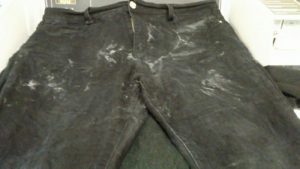
Residue left on freshly laundered clothes is frustrating and expensive because most of the time you need to rewash the items to get rid of it.
There are several culprits that contribute to this. Through process of elimination, hopefully you’ll be able to solve your residue problem.
Undissolved Detergent
When you are using a top loading machine always pour powdered detergent into the empty washer first before loading clothes. This will give it time to dissolve as the machine fills with water.
If you are washing in cold water the powdered detergent may not dissolve entirely. For best results with cold water and powdered detergent, dissolve it first in a cup of hot water before adding to the washer.
NEVER pour detergent directly on dry clothes or throw the detergent pack (Pod) on top of the load. Doing so will not let the detergent disperses evenly, causing blue or green streaks to appear on lighter clothing.
If you have a front loading washer, or with a top loader with an automatic detergent dispenser, it may be clogged with lumps of detergent. Even liquid products will clump. Remove all detergent dispensers and clean with hot water mixed with 1/2 cup distilled white vinegar. Make sure it’s not apple cider vinegar.
If the dispensers are not removable. Fill each dispenser with heated pure distilled white vinegar and allow to sit for at least 30 minutes. Then run a wash cycle with no laundry in the drum to clean out the dispensers.
Too Much Detergent
More is not always better. Using too much detergent can leave residue on clothes.
This is particularly true in high-efficiency washers – both top loading and front loading. These washers use much less water during the wash and rinse cycles. Using more than 3 teaspoons (yes, 3 teaspoons) of detergent will leave residue in and on your clothes.
Too much fabric softener
Never pour fabric softener directly on wet clothes and always use the smallest recommended amount. If you have an automatic dispenser, clean it frequently.
Clogged or Failing Water Pump
If the water in the wash or rinse cycle is draining too slowly, it could be lint, undissolved detergent and/or soil. This can be redeposit on your clothes.
Many new washers have a small door near the bottom of the washer to access the filter right above the water pump. On older washers, you will have to access from the back of the machine in order to clean the pump area.
Open the area to your drain line filter and be sure that it is not clogged with lint or small items that could slow the flow of rinse water.
If you have cleaned the filter and the washer is still slow to drain, the water pump is probably failing.
Overloading Washer
Stuffing too many items into a washer doesn’t leave room for the clothes to move around freely and for the soil and residue to be washed away.
Dirty Washer
If you have never cleaned your washer, it can have soil, minerals and detergent residue that can build-up and redeposit on clothes. It’s like the soap scum in your shower. This is because of the small amount of water in HE, high efficiency, machines. You need to clean HE washers monthly and a standard machine at least twice per year.
Washing With Hard Water
Hard water can react with detergents and leave mineral deposits that remain on clothes.
Get Rid of the Residue
Once you have eliminated all of the causes of the problem, the only way to get rid of the residue is to rewash the clothes. Wash the stained items again in the hottest water suitable for the fabric but DO NOT add any detergent or fabric softener. Instead, add one cup of distilled white vinegar to the wash cycle to help fibers relax slightly and release the residue.




